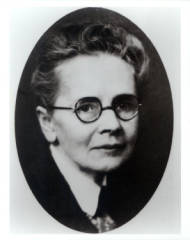As part of our ongoing “Women in Architecture” series at Optima, we’re taking a look at another pioneering female figure: Julia Morgan. Like many of the women in this series, Morgan boasts a series of industry firsts. Morgan was the first woman admitted to the architecture program at l’École nationale supérieure des Beaux-Arts in Paris, and the first woman architect licensed in California. Learn more about her extraordinary life and work below:
The Life of Julia Morgan
Julia Morgan was born on January 20, 1872, to parents Charles Bill Morgan and Eliza Woodland Parmelee Morgan as the second of five children. Morgan was also born into generational wealth — her mother Eliza was the daughter of a cotton trader and millionaire. This financial mobility also provided geographic mobility. The Morgans lived on the West Coast, but travelled often to New York to visit mother Eliza’s parents. It was on one of these trips that Julia Morgan (now age six) met her older cousin Lucy Thornton, who was married to successful architect Pierre Le Brun.
Morgan kept in touch with Le Brun, who encouraged her to pursue higher education, and in 1890, Morgan did just that. She went on to study engineering at the University of California, where she was often the only woman in her math, science, and engineering courses. When she graduated in 1894 (with honors, no less), Morgan became the first woman to earn a B.S. degree in engineering at Berkeley. Encouraged by her professor and mentor, architect Bernard Maybeck, Morgan then went on to be the first woman admitted to study architecture at Maybeck’s alma mater, the prestigious École nationale supérieure des Beaux-Arts in Paris.
Morgan was able to apply to the architecture program thanks in large part to a union of French women artists who pressured the school. When Morgan went to Paris and met this group of women, they introduced her to feminist ideology. And though the Beaux-Arts program prohibited older scholars and Morgan’s 30th birthday (and deadline as a student) approached, Morgan nonetheless earned her certificate in architecture — making her the first woman to do so at the Beaux-Arts, and trumping the certificate completion time of her mentor Maybeck by two years.

The Work of Julia Morgan
Morgan’s extraordinary track record and changemaker ways also carried over to her career. After her education and experience in Paris, she returned to California where she worked with San Francisco architect John Galen Howard, the supervisor of the University of California Master Plan. In this role, she was the primary designer for the Hearst Greek Theater and also provided the decorative elements for the Hearst Mining Building.
In 1904, Morgan became the first woman to obtain an architecture license in California and she opened her own office in San Francisco shortly after. In addition to being a woman of firsts, Morgan also became a woman that could withstand a series of natural disasters. When her office burned down in 1906, she reopened just a year later in the heart of San Francisco’s financial district. Meanwhile, her first reinforced concrete structure, the 72-foot bell tower at Mills College, El Campani, was constructed in 1904 — and just two years later, famously survived the 1906 San Francisco earthquake unscathed.

The survival of the bell tower launched Morgan’s career and rounded out her reputation, while the devastating aftermath of the earthquake provided countless opportunities to rebuild local structures. Morgan famously redesigned the landmark Fairmont Hotel in San Francisco in just one year, using her new signature: earthquake-resistant reinforced-concrete. This project greatly impressed the Hearst family — among many others — and earned Morgan future projects such as the Hearst Castle (one of the most defining projects of her career) and the opportunity to design a series of YWCA (Young Women’s Christian Association) buildings across California.
Though Morgan’s accolades are highly impressive, she lived a notably modest and quiet personal life, having never married, written or spoken much about herself. Despite these humble traits, Morgan nevertheless leaves an ongoing legacy in the strides she made for women in architecture, and the iconic structures she left behind.

